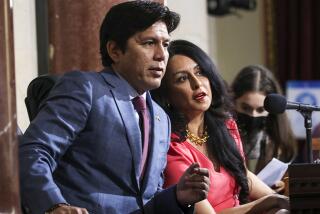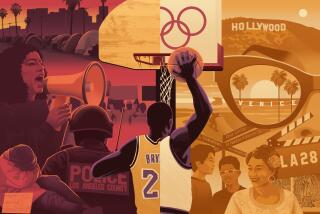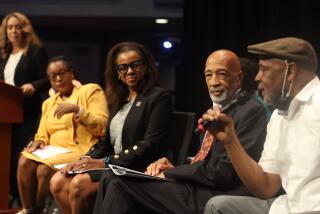Media Is Blind to Latinos Among Us
- Share via
Tacos. Margaritas. Olivera Street. Spanish tile roofs. Cinco de Mayo. Brown faces. Spanish voices.
Hello, does anybody in the Los Angeles media habla Latino? Are we invisible or que ? Is 41 (as in Latinos being 41% of the city of Los Angeles’ population) a bigger number than 37 (percentage of Anglos) and 13 (the African-American population) and 10 (Asian-American) or what?
You wouldn’t know it by either the “One Year After the Riots” piece by Greg Braxton and Claudia Puig (“We’re Always Being Treated to the Worst,” Calendar, April 26) or by the two-hour prime-time waste by KCAL Channel 9 called “Crisis & Recovery--A Town Hall Meeting.” Latinos were virtually invisible in both these reporting efforts.
It’s got to change or L.A. won’t heal.
You cannot systematically exclude or ignore 41% of the population when you talk about the riots and the aftermath. The L.A. media apparently doesn’t understand the significance that 40% of all the businesses destroyed in the riots were Latino businesses. Sure, the Asians, especially Koreans, have gotten short shrift from the media, but as Latinos, we’ve gotten no shrift.
* The Times’ piece points out that Latinos, Asian-Americans and African-Americans claim local television and radio have broken promises to provide more insightful and balanced coverage of urban minority communities in the year since the riots.
Yet, in terms of reaching out to the community, the article itself quotes one Asian-American, one Latina and six African-Americans, not counting the news directors and programming chiefs. That’s hardly balanced community input.
* The KCAL special “Crisis & Recovery” ran for two hours and 56 people were interviewed. Of those, 61% (34 people) were black, 14% (eight) were Latino, 9% (five) were Asian-American and 16% (nine) were Anglo. Worse yet, of the 56 interviews, 79% were men (44) and only 21% (12) were women.
That’s balance? How in the world can we get along if we’re not given the vehicles to communicate fairly and on an equal basis with one another?
Why is it that 13% of the population (African-Americans) dominated 75% of the L.A. Times interview and 60% of the KCAL piece? Why did the 41% Latino population only get 12% of the L.A. Times’ attention and only 14% of the KCAL interviews? Don’t Asians and Anglos count any more in L.A.?
Others in the media have also been guilty of Latino and Asian-American omission. The media efforts at getting L.A.’s diverse population to talk about its problems are admirable. But in the final analysis, the media’s defense of itself as being fair and objective and providing a public service rings hollow.
Eldridge Cleaver wrote in “Soul on Ice” that in life, one is either “part of the solution, or part of the problem.” The media events and stories of recent days and months clearly show that newspapers, radio and television are still failing to involve the diverse ethnic, economic, political and geographic elements of Los Angeles in the discussions about healing.
A year after the riots, little has changed in how our communities are portrayed, either in real-life stories or in these contrived town-hall meetings. Therefore, the media remains a part of the problem.
Wake up and smell the refried beans.
More to Read
Sign up for Essential California
The most important California stories and recommendations in your inbox every morning.
You may occasionally receive promotional content from the Los Angeles Times.










